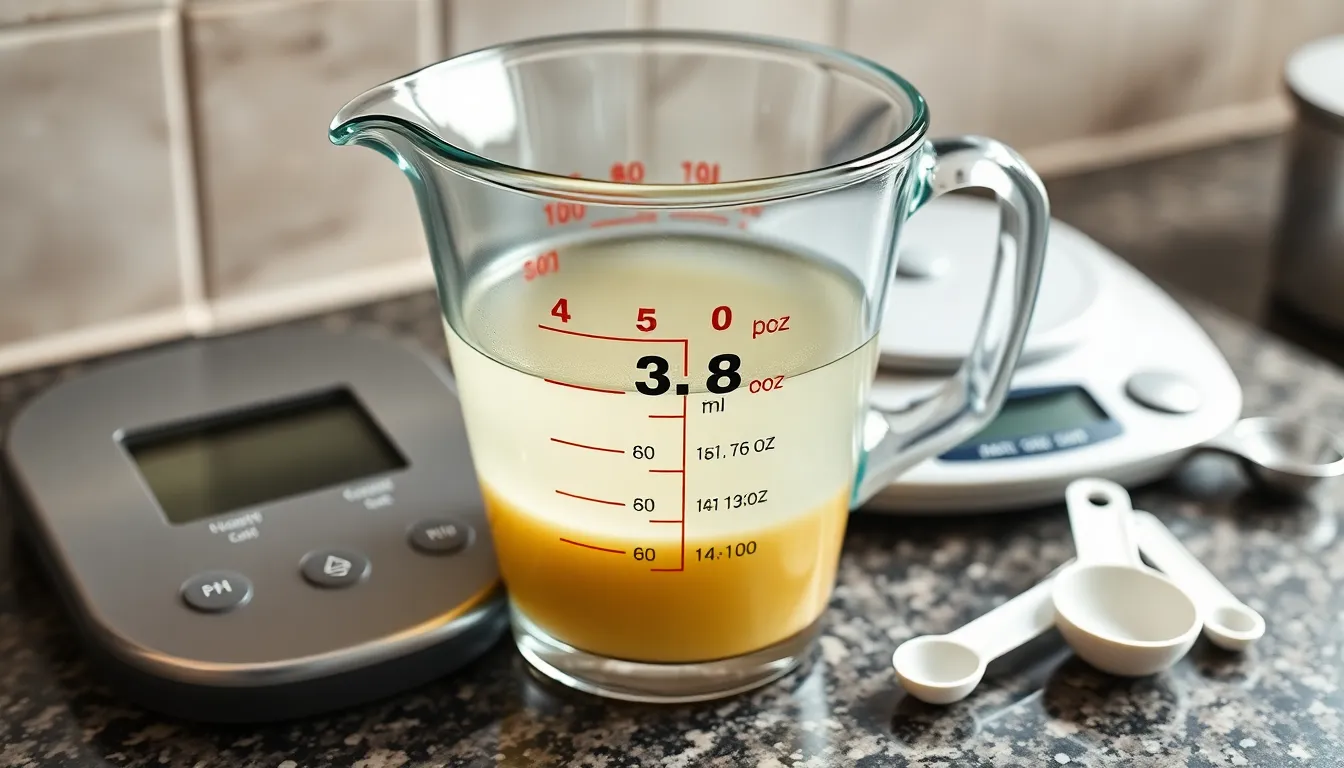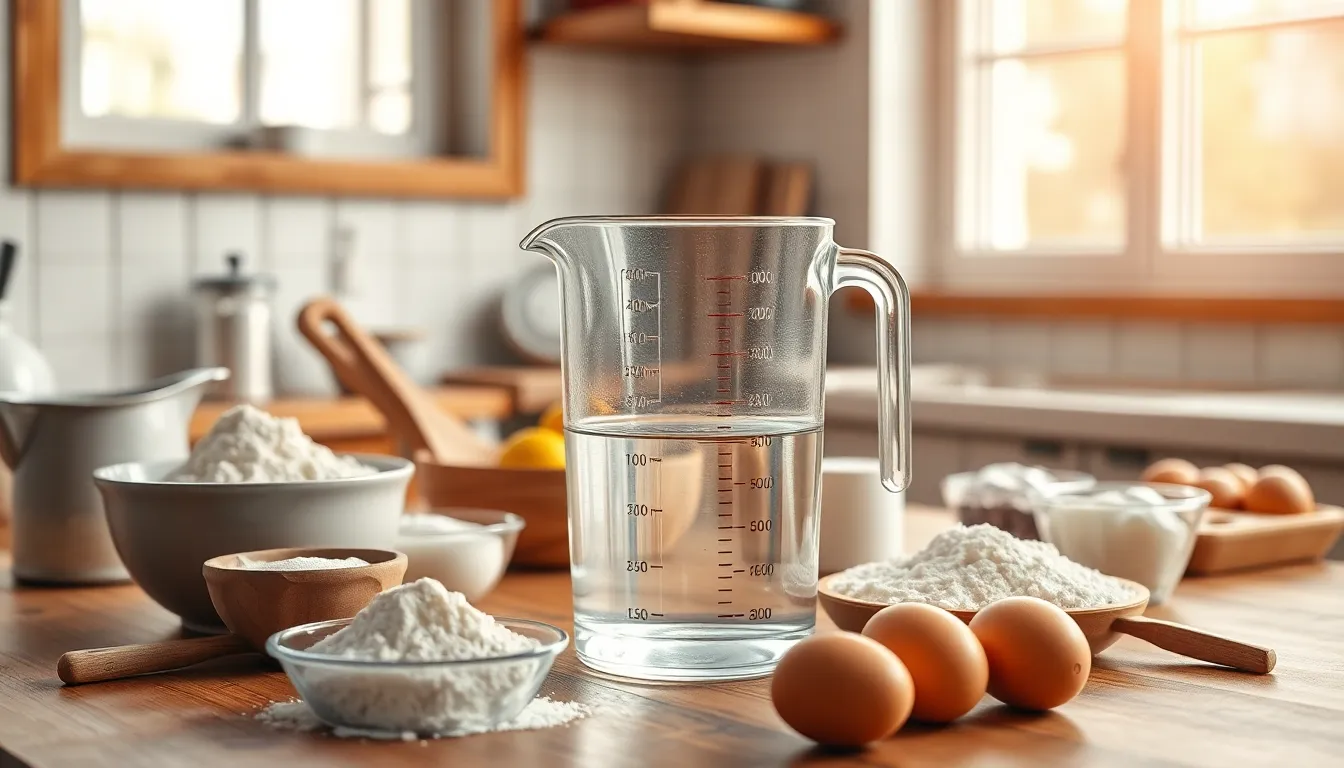Table of Contents
ToggleConverting fluid ounces to milliliters can be a common task, especially for those who love cooking or experimenting with beverages. When it comes to 33.8 fluid ounces, understanding its equivalent in milliliters can help ensure precise measurements for recipes or nutritional tracking.
This conversion is particularly useful in a world where metric measurements are widely used. With 33.8 fl oz being a popular size for bottled beverages, knowing how to translate this measurement into milliliters can enhance one’s culinary skills and make shopping for ingredients much easier.
In this article, readers will discover the exact conversion and gain insights into why these measurements matter in everyday life. Whether for cooking, baking, or simply staying hydrated, mastering this conversion can simplify many tasks.
Understanding Fluid Ounces and Milliliters
Fluid ounces and milliliters represent common units of volume, essential for accurate measurement in cooking and beverage preparation. Understanding their conversions facilitates precise recipe execution and appropriate beverage serving.
Conversion Factors
- Fluid Ounces to Milliliters: The conversion factor for fluid ounces to milliliters is approximately 29.5735. To convert fluid ounces to milliliters, multiply the number of fluid ounces by this factor. For example, 33.8 fl oz equals about 1,000 ml (33.8 x 29.5735 ≈ 1,000).
- Milliliters to Fluid Ounces: To convert milliliters back to fluid ounces, divide the number of milliliters by 29.5735. For instance, 1,000 ml converts to approximately 33.8 fl oz (1,000 ÷ 29.5735 ≈ 33.8).
Common Uses of Each Measurement
- Fluid Ounces:
- Used in recipes for beverages.
- Common in nutritional labels for serving sizes.
- Found in restaurant menus for drink portions.
- Milliliters:
- Used in scientific measurements and laboratory settings.
- Common in metric recipes, especially in international cooking.
- Preferred in medical prescriptions for liquid medications.
The Conversion Process for 33.8 fl oz

Converting 33.8 fluid ounces to milliliters requires a straightforward calculation using the conversion factor. This section outlines the step-by-step process and provides examples for clarity.
Step-by-Step Calculation
- Identify the conversion factor: The precise conversion factor is 29.5735 milliliters per fluid ounce.
- Multiply by the number of fluid ounces: Multiply 33.8 by 29.5735.
- Perform the calculation:
[
33.8 , text{fl oz} times 29.5735 , text{ml/fl oz} = 1000 , text{ml}
]
- Result: Thus, 33.8 fluid ounces equals 1000 milliliters. This calculation demonstrates how fluid ounces translate into milliliters effectively.
Example Conversions
To emphasize the conversion’s utility, here are additional examples involving various fluid ounce quantities:
| Fluid Ounces (fl oz) | Milliliters (ml) |
|---|---|
| 8 | 236.588 |
| 16 | 473.176 |
| 32 | 946.353 |
| 64 | 1892.706 |
These examples illustrate the fluid ounce-to-milliliter conversion for common volumes, enhancing comprehension of measurement variations in practical contexts.
Practical Applications
Understanding the conversion from 33.8 fluid ounces to milliliters plays a crucial role in numerous everyday activities. This section delves into various applications in cooking, baking, and health-related fields.
Cooking and Baking
Accurate measurements are vital in cooking and baking, where ingredient ratios directly affect the final outcome. Many recipes utilize fluid ounces for liquids, but globally recognized measurements often reflect milliliters. For example, a recipe requiring 33.8 fl oz of water translates to 1000 ml, ensuring precise hydration levels for dough or batter. Chefs and home cooks frequently rely on this conversion to produce consistent results, whether preparing sauces, marinades, or baked goods. This understanding promotes flexibility in adapting recipes from different cultures, facilitating culinary exploration.
Medical and Nutritional Contexts
In medical and nutritional contexts, accurate conversions impact health outcomes. Many dietary guidelines provide liquid measurements in milliliters for clearer understanding and adherence. Nutritional labels also present serving sizes in milliliters, offering standardized information for consumers. For instance, a beverage providing 33.8 fl oz delivers approximately 1000 ml, equating to roughly four standard servings. Healthcare professionals recommend this conversion for dosage calculations, especially in liquid medications. This measurement competency improves patient care and enhances dietary compliance, supporting overall well-being.
Tools for Conversion
Accessible tools simplify the conversion of 33.8 fluid ounces to milliliters. Utilizing online calculators and conversion charts can facilitate quick and accurate measurements.
Online Calculators
Online calculators streamline the conversion process for fluid ounces to milliliters. Users can input their desired fluid ounce value and receive instant results in milliliters. Numerous websites and mobile applications, such as UnitConversions.net and RapidTables.com, offer user-friendly interfaces. Some calculators even provide batch conversion options, allowing users to convert multiple fluid ounce measurements simultaneously. These tools ensure precision, especially beneficial in contexts demanding accurate measurements, such as cooking and medication preparation.
Conversion Charts
Conversion charts offer a quick reference for converting fluid ounces to milliliters. These charts typically display a range of fluid ounce values alongside their corresponding milliliter equivalents. For instance, a standard conversion chart may include:
| Fluid Ounces (fl oz) | Milliliters (ml) |
|---|---|
| 1 | 29.5735 |
| 8 | 236.588 |
| 16 | 473.176 |
| 33.8 | 1000 |
| 64 | 1892.706 |
Such charts enable efficient reference, minimizing calculation time in cooking and food preparation. They serve both novice and experienced cooks, ensuring that accurate conversions enhance recipe outcomes.
Understanding the conversion of 33.8 fluid ounces to milliliters is essential for anyone involved in cooking or beverage preparation. This knowledge not only facilitates accurate measurements but also enhances the ability to follow recipes from various cultures.
With 33.8 fl oz equating to 1000 ml, this conversion serves as a practical reference point in both everyday tasks and specialized fields like nutrition and healthcare. Utilizing online tools and conversion charts can further streamline the process, making it accessible for everyone.
Mastering these conversions ultimately leads to improved outcomes in cooking and better adherence to dietary guidelines. Embracing this skill empowers individuals to navigate their culinary and health-related endeavors with confidence.







